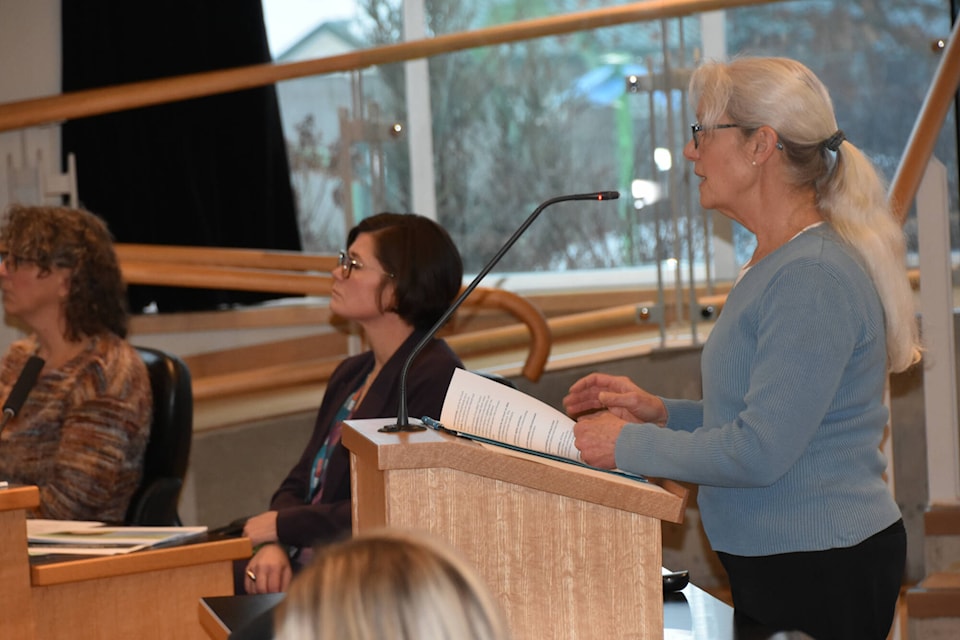Lawn and garden pesticides commonly used in Salmon Arm hold risks to the health of both human beings and nature.
This warning was provided in a report from the city’s Environmental Advisory Committee that was brought to Salmon Arm council, along with recommendations, on Jan. 9.
Two main recommendations from the report included setting up a permitting system as well as removing the broad term ‘pest infestation’ as a reason for pesticide treatment.
Presenter Julia Beatty explained that a working group was formed in 2021 to look at the city’s Pesticide Use Control Bylaw, which is outdated and in need of overhaul.
“Our review has only verified our deep concerns about the extensive use of unnecessary pesticides within the City of Salmon Arm,” she said.
Exposure to pesticides has been linked to a variety of diseases and conditions, the report stated, including Parkinson’s and Alzheimer’s, as well as respiratory diseases and types of cancers. The introduction of pesticides can also significantly impact ecosystems. Impacts to pollinators such as bees are just one effect.
The bottom line, she said, is “we know pesticides are linked to significant and serious human and ecological threats.”
Read more: Vertical farm business turns judges’ heads in Shuswap Launch-A-Preneur
Beatty said that while people might think that products approved for sale by federal and provincial governments are problem free, several limitations are present in the registration process.
The process doesn’t keep up with recent or more complex research. Canada also doesn’t require data on long-term, low dose exposure to products, nor on cumulative and multiple exposures. She said weed and feed products, for instance, are a mixture of herbicides, and such products “are used on hundreds of lawns every year in Salmon Arm by contractors and are sold to many residents at outlets in the city.”
She said the regulatory process ignores the risk to fetuses, small children and pets.
Beatty said chemicals added to products are often not named. For example, the surfactant in glyphosate is at least as toxic to sensitive fish species as the active ingredient, she said.
She added that the federal review process also relies too much on data provided by industry.
“Risks of pesticide exposure have been repeatedly underestimated by Health Canada leaving serious questions about the safety of approved pesticides,” she concluded.
The Salmon Arm working group also looked at other provinces and municipalities. Many have adopted complete bans while others have bans with only some exemptions for human or infrastructure safety, Beatty said. Of note was all the provinces that have banned cosmetic pesticides, have incorporated a public education campaign.
She said a combination of carrot and stick are key – permits plus education.
Read more: 2016 - City returns to pesticide use on streets
Setting up a permitting system for public and private pesticide use was one recommendation the report strongly urged.
The permitting system would apply only to non-permitted pesticides, which are those not listed on Schedule 2 of the province’s Integrated Pest Management Regulation (BC IPMR). Schedule 2 contains 51 excluded pesticides, not by brand name but by component.
Once an application to the city was reviewed and, if approved, the applicant would be required to post a sign on their property indicating the type of pesticide used and time of application.
Along with the permit and sign, a pamphlet would be issued describing the environmental and health safety concerns for use of pesticides. The report said permit fees could cover the permitting system as well as the costs of an educational campaign. The fees could potentially also provide funds for a summer student to implement an education and awareness program, helping to use a soft approach to changing behaviours.
The second recommendation was that the use of “pest infestation” as a criterion for pesticide treatment be removed from the existing bylaw, because the definition is far too subjective, the report stated. Instead, the permitting system would require permits for all pesticide uses, and exempt only those listed on Schedule 2 of the BC IPMR.
Read more: Painkillers, pesticides and cocaine among contaminants found in Fraser Valley floodwaters
Both Coun. Sylvia Lindren, chair of the Environmental Advisory Committee, and working group members were thanked for all their work.
Coun. Tim Lavery said he thinks public education and permit fees make sense. He also noted that six years ago concerns were raised about BC Hydro spraying under transmission lines. From that came an annual report from Hydro, which he asked about. Staff said they would contact the Crown corporation to ensure the city gets them.
Lavery also mentioned the railway and forest tenure lots. Beatty said those types of pesticide uses are under provincial jurisdiction.
Lavery asked what happens when provincial and local rules differ. During discussion, Mayor Alan Harrison pointed to the city’s single-use plastic bag ban, where the courts said municipalities couldn’t do it but then provincial legislation changed and the city could.
Council said it would consider the information provided on the need for a new pesticide bylaw.
Read more: Column - Mother orca’s display of grief sends powerful message
martha.wickett@saobserver.net
Like us on Facebook and follow us on Twitter and subscribe to our daily newsletter.
